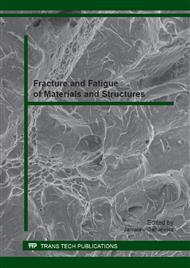[1]
O'Dowd, N.P., Shih, C.F., "Family of crack-tip fields characterised by a triaxiality parameter-I. Structure of fields", Journal of the Mechanics and Physics of Solids, Vol. 39, (1991).pp.898-1015
DOI: 10.1016/0022-5096(91)90049-t
Google Scholar
[2]
Yang S, Chao YJ, Sutton MA. "Higher Order Asymptotic Crack Tip Fields in a Power-Law Hardening Material, Engineering Fracture Mechanics; Vol.45, (1993),p.20.
DOI: 10.1016/0013-7944(93)90002-a
Google Scholar
[3]
Guo W. "Elastoplastic three dimensional crack border field - I. Singular structure of the field". Engineering Fracture Mechanics; Vol. 46 No.1,(1993), pp.93-104
DOI: 10.1016/0013-7944(93)90306-d
Google Scholar
[4]
Beremin N. "A local criterion for cleavage fracture of a nuclear pressure vessel steel", Met. Transaction A, Vol. 14A, (1983), pp.2277-2287.
DOI: 10.1007/bf02663302
Google Scholar
[5]
Gao X, Dodds RH. "An engineering approach to assess constraint effects on cleavage fracture toughness". Engineering Fracture Mechanics, Vol. 68, (2001),263-283
DOI: 10.1016/s0013-7944(00)00102-8
Google Scholar
[6]
Gao X, Ruggieri C, Dodds RH. "Calibration of Weibull stress parameters using fracture toughness data", Int. J Fract. Vol. 92, (1998), pp.175-200
Google Scholar
[7]
Berdin, C., Besson J., Bugat S., Desmorat R., Feyel F., Forest S., Lorenz E., Maire E., Pardoen T., Pineau A., Tanguy B., (2004), Edited by Besson J., "Local Approach to Fracture", Eccole des Mines de Paris, Les Presses,.
Google Scholar
[8]
Ritchie, R.O., Knott, J.F., Rice, J.R., "On the Relationship Between Tensile Stress and Fracture Toughness in Mild Steels", Journal of the Mechanics and Physics of Solids, Vol. 21, (1973), pp.395-410.
DOI: 10.1016/0022-5096(73)90008-2
Google Scholar
[9]
Neimitz A., Graba, M., Gałkiewicz J. "An alternative formulation of the Ritchie-Knott-Rice local fracture criterion", Engineering Fracture Mechanics, Vol.74, No.8, (2007), pp.1308-1322
DOI: 10.1016/j.engfracmech.2006.07.015
Google Scholar
[10]
Neimitz A., Gałkiewicz J., Dzioba I., "The ductile to cleavage transition in ferritic Cr-Mo-V steel: A detailed microscopic and numerical analysis", Engineering Fracture Mechanics, vol.77, (2010), pp.2504-2526
DOI: 10.1016/j.engfracmech.2010.06.003
Google Scholar
[11]
Andrzej Neimitz, Ihor Dzioba, Teijo Limnell, "Master Curve of Ultra High Strength Steel", International Journal of Pressure Vessels and Piping, Vol. 92, (2012), pp. (10-26)
DOI: 10.1016/j.ijpvp.2012.01.008
Google Scholar
[12]
McClintock FA. "A Criterion for Ductile Fracture by Growth of Holes". Journal of Applied Mechanics, Vol. 4, (1968), p.363–371.
DOI: 10.1115/1.3601204
Google Scholar
[13]
Rice, J.R., Tacey, D.M., "On the ductile enlargement of voids in triaxial stress fields", Journal of the Mechanics and Physics of Solids, Vol. 17, (1969), pp.201-217
DOI: 10.1016/0022-5096(69)90033-7
Google Scholar


